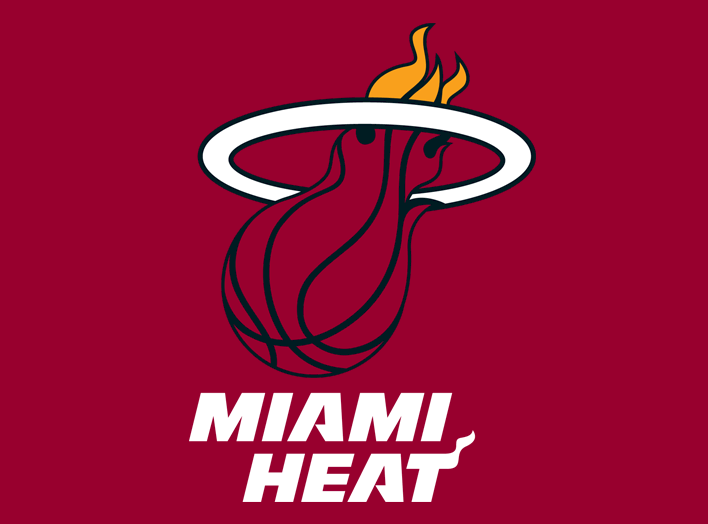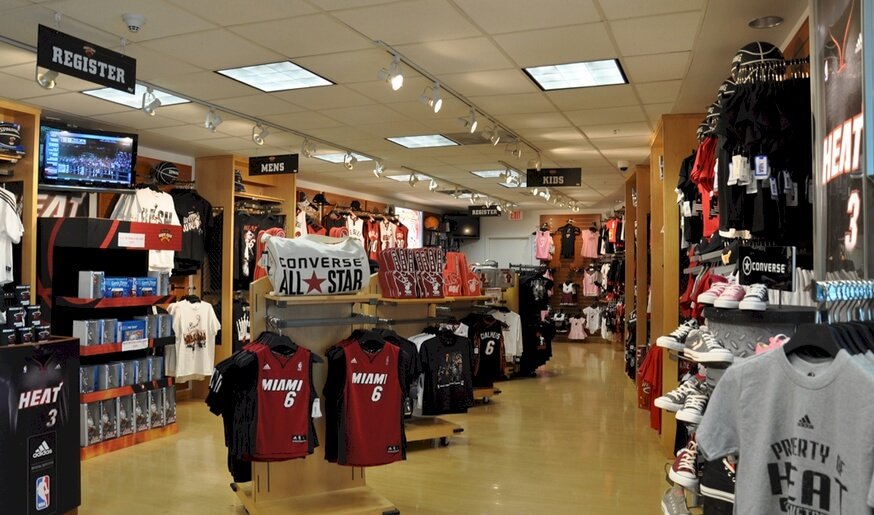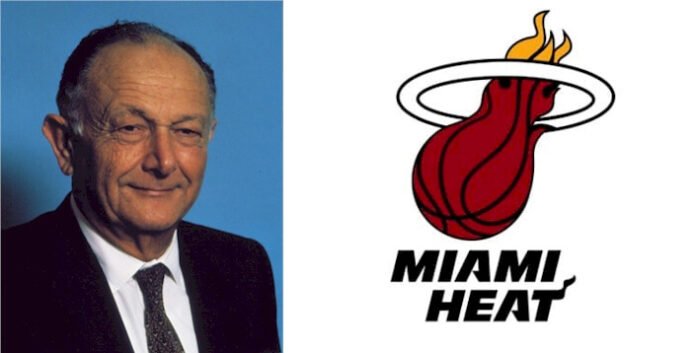The Miami Heat Logo has a no-frills look that hasn’t changed much throughout its relatively short history. All of the changes have had to do with color. It’s a very smart design of a “blazing basketball” dropping through a hoop. There’s a crafty addition of the tip of a flame on the last “T” in the inscription.
In 1999, the Miami Heat emblem underwent a minor redesign, in which the shape and structure didn’t change, but the blazing basketball’s color was changed to red, and the hoop was changed to white.
History and Evolution of Miami Heat Logo

Miami Heat is a basketball team whose logo history is arguably one of the shortest and most modest. The original Miami Heat logo was designed in 1988 and redesigned slightly only once in 1999, retaining everything except for the color palette.
1988-1999
Introduced in 1988, the first-ever Miami Heat logo featured a “burning” gradient orange basketball, alongside a black ring over it as well as an elegant, bold inscription under the emblem.
The lettering was rendered in a contemporary geometric sans-serif font with italicized contours and thick lines, with the tip of letter T in the word “Heat” elongated and drawn like a flame. Another distinctive detail about the font is that both “A” letters in the inscription have a triangular cut, adding style and sharpness to the entire image.
1999 —Present
When Miami Heat’s logo was redesigned in 1999, the color palette was switched to a darker tone and the basketball was drawn in low-key red, and the tip of the flame remained orange. The ring was changed to white, which brought some brightness to a new strong palette.
The lettering remained almost unchanged, with the flame on the bar of “T” going a little to the right. Another version of the logo featured just the graphical part, minus any text below it.
The Miami Heat Logo Design Elements

Shape: The original “blazing basketball” symbol of Miami Heat is an instantly recognizable logo in the history of sports. It comprises a “burning basketball” that falls through a hoop over the team’s name. This logo went through a minor modification in 1999, where the hoop became white, and the “blazing basketball” featured a bright shade of red with an orange flame tip.
Color: The original logo color palette consisted of several orange shades accentuated by black. This choice of color seemed perfectly natural, considering the whole idea of a flame behind the logo. The color palette used in the current Miami Heat logo (white, black, red, and orange) seems more basic, but it has a similar symbolic meaning and boasts all of the NBA team’s official colors.
The red in the Miami Heat logo symbolizes passion, vitality, and determination, while the orange signifies the sun, energy, youthfulness, and activity. On the other hand, the black stands for the elegance, dominance, and supremacy of the team.
Miami Heat Font: In the Miami Heat inscription, the most unique character is the last letter, “T.” There’s a flame-like shape over the horizontal bar of “T.” Given the visual context, the flame shape idea seems completely logical.
Both “A” letters in this customized bold and italicized uppercase inscription are also distinctive and recognizable, with a stylish triangular cut. The rest of the letters look simple and minimalistic.
The History of Miami Heat

Miami Heat, more commonly referred to as “The Heat,” is a Miami-based U.S. professional basketball team that competes in the NBA’s Eastern Conference league. The team has won three NBA titles (2006, 2012, 2013).
Miami Heat, alongside Charlotte Hornets, joined the NBA as a franchise in 1988. In their first season, they won 15 games only but improved massively in the next three NBA seasons, eventually earning a playoff spot in the 1991-92 season, where they were thrashed by eventual champions Chicago Bulls. The Heat earned another playoff spot in the 1993-94 season, only to lose again to Atlanta Hawks.
In 1995, the Heat was taken over by head coach and future Hall of Famer Pat Riley. In only his second season in charge, Riley guided a Miami Heat team featuring All-Stars Tim Hardaway and Alonzo Mourning to a division title and an astonishing 61-21 record. In the 1996-97 playoffs, the Heat beat both Orlando Magic and New York Nicks. The Heat’s run in the playoff came to an end when they lost to Chicago Bulls in the finals of the Eastern Conference.
From 1997-98, Miami Heat won three back-to-back division championships. But the team was knocked out by New York Nicks in all three championship-winning postseasons. The Heat’s six-year playoff run came to an end in the 2001-02 season and, after the side finished last in the 2002-03 season, Riley resigned his head coach position to move upstairs to the team’s board of directors.
In 2003, Miami Heat signed guard Dwayne Wade and won a playoff spot the following season. In 2004, the team brought in Shaquille O’Neal and won 59 games as well as a division championship in the 2004-05 season. They then followed up in the playoffs by sweeping aside Washington Wizards and New Jersey Nets before Detroit Pistons stopped them in the finals of the Eastern Conference.
Head coach Riley returned just 22 games into 2005-06, and the Heat beat Detroit Pistons in a rematch of the conference finals before sweeping aside Dallas Mavericks in a six-game series to clinch their first NBA championship. Rising superstar Wade guided the Heat to several successful seasons from 2006, but the team didn’t make it beyond the preliminaries of all the playoffs.

Miami Heat enjoyed another upturn in fortunes after 2009-10 when free agent Wade signed another long-term contract and welcomed fellow superstars Chris Bosh and LeBron James to the team. The star-studded side received a lot of media attention throughout the 2010-11 season. After a patchy start to that season, the Heat charged through to the playoffs, losing just three games on their way to the finals of the NBA, where they lost their rematch with Dallas Mavericks.
The following season, in 2011-12, Miami Heat made it to the NBA championship finals, where they beat Oklahoma City Thunder. In 2012-13, the Heat posted the second-longest winning run in the history of the NBA (27 wins) and won a record 66 games on their way to a third consecutive appearance in the NBA finals, where they overcame San Antonio Spurs after a dramatic seven-game series.
Miami Heat secured a fourth successive division championship in 2013-14, following it up with another cruise through the playoffs earning a rematch with San Antonio Spurs in the finals of the NBA, becoming the first basketball side to make four successive finals appearances in 27 years. But the Heat lost their second finals showdown with San Antonio Spurs after five games.
During the next off-season, all three of Miami Heat’s superstars tore up their contracts to give the team more financial flexibility and reassess their options. It was at that time, the team was said to be operating well above the NBA’s salary cap.
Chris Bosh and Dwayne Wade both re-signed with the Heat, but LeBron James left to return to hometown team Cleveland Cavaliers. As a result, the Heat failed to make it to the playoffs in 2014-15 in a pretty weak Eastern Conference. The following season, the team bounced back, winning 48 games en route to a playoff berth, where they were kicked out in the second round.
Miami Heat’s Main Rivals
New York Knicks: The rivalry between Miami Heat and New York Knicks came about after their four successive playoff series between 1997 and 2000. Each of the series had seven games. The central figure of this rivalry was Pat Riley, who coached the Knicks in the early 1990s and the Heat in the late 1990s.
Jeff Van Gundy replaced Riley as the Knicks head coach, while Stan Van Gundy (his elder brother) was the Heat’s assistant coach at the same time. Alonzo Mourning and Patrick Ewing had been pals from their time as teammates at Georgetown College Basketball Team. One of Knicks’ stars, Larry Johnson, never saw eye to eye with Mourning dating back to their time together at Charlotte Hornets.
Chicago Bulls: Miami Heat’s rivalry with Chicago Bulls started once the Heat became serious contenders in the 1990s when Michael Jordan and the Bulls reigned supreme. During that decade, the Bulls eliminated the Heat three times, going on to seal the NBA title each time.
After the retirement of Jordan and the Heat’s decline at the turn of the millennium, the rivalry cooled down but picked up slightly when Miami Heat faced the Bulls in the 2006 playoffs. The Heat defeated the Bulls 4-2 over six games and proceeded to clinch the NBA finals. In round one of the following season, the Bulls would beat the defending champions Miami Heat.
The rivalry picked up again with the renaissance of Chicago Bulls and the rise of hotshot Derrick Rose, as well as the Heat’s re-signing of Dwayne Wade along with the acquisition of superstars LeBron James and Chris Bosh. Incidentally, Dwayne Wade turned down the chance to join his hometown team, the Bulls, before re-signing with the Heat. LeBron James also turned down the chance to team up with Rose at Chicago Bulls. The renewed rivalry has been extremely physical, involving serious fouls and rough play between rival sets of players. Both teams faced off in the Eastern Conference finals in 2011, with the Heat defeating the Bulls in five games.
Boston Celtics: Miami Heat first squared off with Boston Celtics in the 2010 playoffs, with the Celtics overcoming the Heat 4-1 en route to the Celtic’s eventual appearance in the NBA finals. Having suffered three successive first-round losses, the loss to Boston Celtics prompted Wade to announce that this would be his last first-round loss in the foreseeable future.
Dallas Mavericks: The rivalry between Miami Heat and Dallas Mavericks started during the NBA finals of 2006, where the two sides squared off, and both made their first appearance in the NBA finals. A year earlier, the Heat had signed Shaquille O’Neal. Dirk Nowitzki captained the Mavericks while Dwayne Wade skippered the Heat.
Indiana Pacers: Miami Heat and Indiana Pacers faced off in the 2012 NBA Eastern Conference playoff semi-finals, triggering a new rivalry. Although both teams previously squared off in the NBA playoffs of 2004 (when the Pacers won 4-2), the only surviving player from either side in 2014 was Miami Heat’s, Udonis Haslem.
Orlando Magic: The Heat are rivals of Orlando Magic since both teams are based in Florida. Therefore, the rivalry is called the Sunshine State derby. Another ingredient to this rivalry was the superstars on both teams, like Orlando’s Penny Hardaway and Shaquille O’Neal and Miami’s Tim Hardaway and Alonzo Mourning.
The two teams had first faced each other in the 1997 NBA playoff finals, with the Heat defeating Orlando 3-2. Since then, they’ve not faced off in the playoffs.
The rivalry went up several notches with the emergence of Orlando Magic’s and Miami Heat’s Dwight Howard and Dwayne Wade, respectively, along with Miami’s acquisition of superstars such as Chris Bosh and LeBron in 2010, triggering fierce rivalry between the pair.
Summing Up the History of Miami Heat

The Miami Heat team is a renowned American professional basketball team competing in the Eastern Conference league of the NBA. Located in Miami, Florida, Miami Heat was established as an NBA franchise in 1988. Alongside Orlando Magic, they’re the two sole NBA franchises that fly the flag for Florida.
Miami Heat has experienced several highs and lows throughout its stint in the NBA. The team finally secured the NBA championship in 2006, beating Dallas Mavericks. The Heat grabbed media headlines in 2010 by drafting Chris Bosh and LeBron James to play with Dwayne Wade, putting together what many believed was a multiple championship winning team.
Miami Heat has won three NBA championships (2006, 2012, 2013), five Eastern Conference championships, and 11 division titles. The team and the Miami Heat logo is recognized by millions of sports fans across the world.
According to Forbes, Miami Heat was the 10th most valuable NBA franchise in 2016, valued at $1.3 billion.







